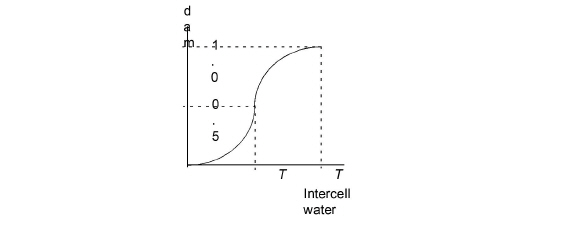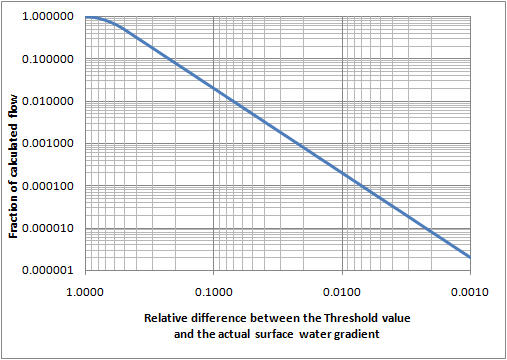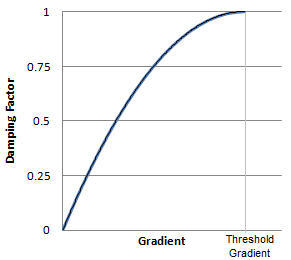
In flat areas with stable ponded water, both the flow gradient and the water depth difference between grid cells will be zero or nearly zero. Equation (24.17) implies that as dh goes to zero Dt also goes to zero. To allow the simulation to run with longer time steps and dampen any numerical instabilities in areas with very low lateral flow, the calculated intercell flows are multiplied by a damping factor when the flow gradient between cells is close to zero.
Essentially, the damping factor reduces the flow between cells. You can think of the damping function as an increased resistance to flow as the flow between cells goes to zero. In other words, the flow goes to zero faster than the time steps goes to zero. This makes the solution more stable and allows for larger time steps. However, the resulting intercell flow will be lower than that calculated using the Mannings equation in the affected cells and neighbouring water levels will take longer to equilibrate. At very low flow gradients this is normally insignificant, but as the flow gradient increases the differences could become noticeable. Therefore, the damping function is only applied below a user-defined flow gradient.

Figure 24.3 Default damping function for numerical stability at low gradients
The default damping function is a pair of parabolic equations (see Figure 24.3). When the flow gradient between cells reaches the threshold the following damping function is applied
where T is the user-specified threshold gradient, dx is the cell size and dZ is the water level difference between the two nodes. When the water level difference reaches T dx/2, the damping function changes to
which goes to zero as the water level difference goes to zero.
In the log-log graph in Figure 24.4, you can see that the lateral flow betwen cells drops off very quickly when the Threshold is active. For example, if the difference between the surface water gradient and the Threshold gradient is 0.1, then the actual flow will only be 2% of the original flow. If the difference is 0.01, then overland flow will be essentially turned off between cells.

Figure 24.4 Actual overland flow as a function of the difference between the threshold gradient and the surface water gradient based on Equations (24.19) and (24.20).
Alternative damping function
An alternative damping function is available as an Extra Parameter that goes to zero more quickly and is consistent with the function used in MIKE FLOOD.
The alternative function is a single parabolic function (see Figure 24.5)
(24.21) 

Figure 24.5 Alternative damping function activated by an Extra Parameter.
To activate the alternate function, you must specify the Alternative low gradient damping function (V1 p. 745) boolean parameter in the Extra Parameters (V1 p. 347) dialog.
For both functions and both the explicit and implicit solution methods, each calculated intercell flow in the current timestep is multiplied by the local damping factor, FD, to obtain the actual intercell flow. In the explicit method, the flow used to calculate the courant criteria are also corrected by FD.
The damping function is controlled by the user-specified threshold gradient (see Common stability parameters (V1 p. 193) for the Overland Flow), below which the damping function becomes active.